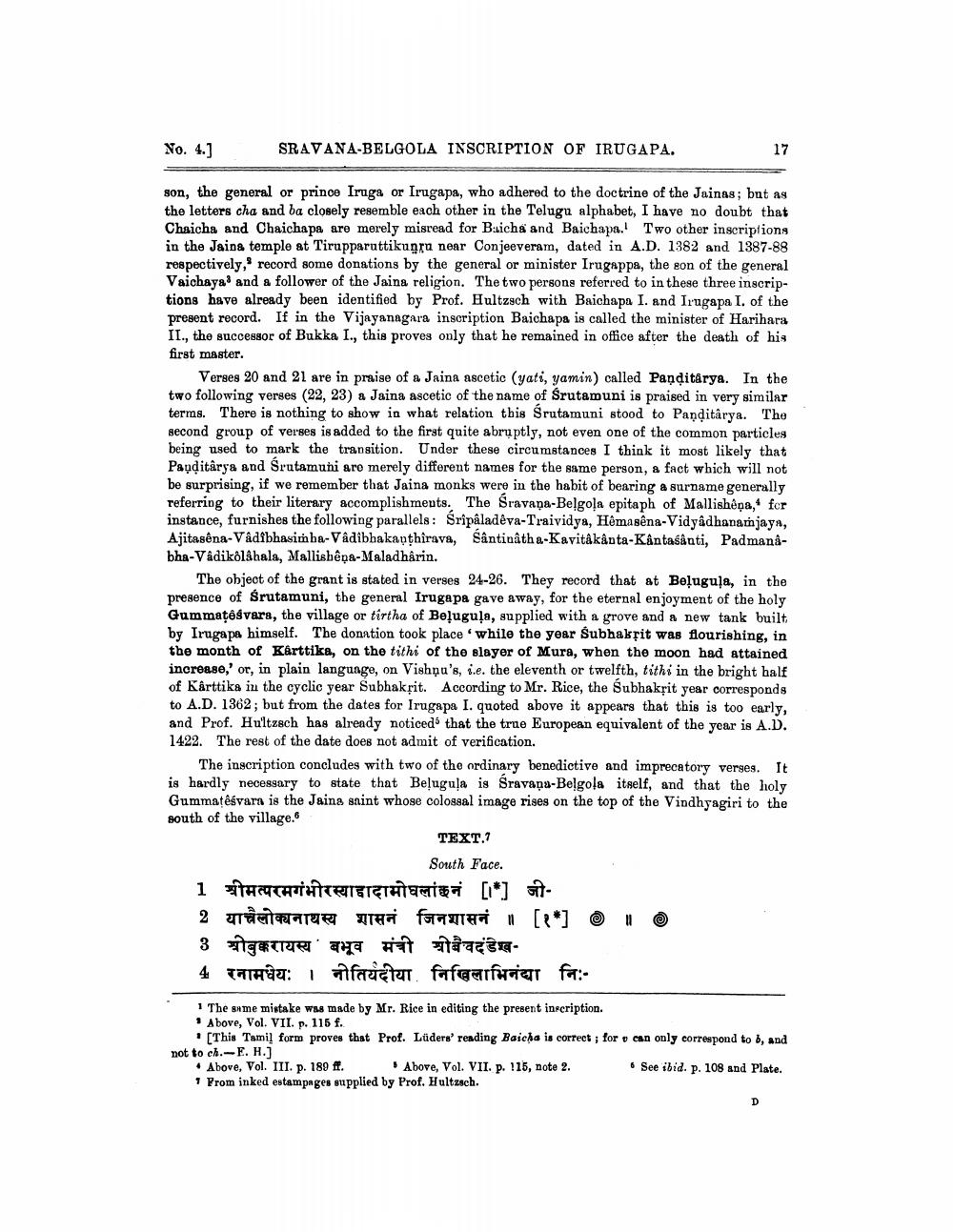________________
No. 4.]
SRAVANA-BELGOLA INSCRIPTION OF IRUGAPA.
17
son, the general or prince Iruga or Iragapa, who adhered to the doctrine of the Jainas; but as the letters cha and ba closely resemble each other in the Telugu alphabet, I have no doubt that Chaicha and Chaichapa are merely misread for B-icha and Baichapa. Two other inscriptions in the Jaina temple at Tirupparuttikugra near Conjeeveram, dated in A.D. 1382 and 1387-88 respectively, record some donations by the general or minister Irugappa, the son of the general Vaichayad and a follower of the Jaina religion. The two persons referred to in these three inscriptions have already been identified by Prof. Hultzsch with Baichapa I. and Irugapa I. of the present record. If in the Vijayanagara inscription Baichapa is called the minister of Harihara II., the successor of Bukka I., this proves only that he remained in office after the death of his first master.
Verses 20 and 21 are in praise of a Jaina ascetic (yati, yamin) called Panditärya. In the two following verses (22, 23) a Jaina ascetic of the name of Srutamuni is praised in very similar terms. There is nothing to show in what relation this Srutamuni stood to Panditârya. The second group of verses is added to the first quite abruptly, not even one of the common particles being used to mark the transition. Under these circumstances I think it most likely that Panditarya and Srutamuni are merely different names for the same person, a fact which will not be surprising, if we remember that Jaina monks were in the habit of bearing a surname generally referring to their literary accomplishments. The Sravana-Begola epitaph of Mallishèqa,for instance, furnishes the following parallels: Sripaladeva-Traividya, Hêmasêna-Vidyadhanamjaya, Ajitasêna-Vâdibhasimba-Vadibbakanthirava, Sântinatha-Kavitâkânta-Kântaśânti, Padmanabha-Vadikólahala, Mallisbêņa-Maladhârin.
The object of the grant is stated in verses 24-26. They record that at Beļugula, in the presence of śrutamuni, the general Irugapa gave away, for the eternal enjoyment of the holy Gummatêsvara, the village or tirtha of Beļuguļa, supplied with a grove and a new tank built by Irugapa himself. The donation took place while the year Subhaksit was flourishing, in the month of Kärttika, on the tithi of the slayer of Mura, when the moon had attained increase,' or, in plain language, on Vishņu's, i.e. the eleventh or twelfth, tithi in the bright half of Kärttika in the cyclic year Subhaksit. According to Mr. Rice, the Subhaksit year corresponds to A.D. 1362; but from the dates for Irugapa I. quoted above it appears that this is too early, and Prof. Hultzsch has already noticed that the true European equivalent of the year is A.D. 1422. The rest of the date does not admit of verification.
The inscription concludes with two of the ordinary benedictive and imprecatory verges. It is hardly necessary to state that Belugula is Sravaņa-Belgola itself, and that the holy Gummatêsvara is the Jains saint whose colossal image rises on the top of the Vindhyagiri to the south of the village.
TEXT.7
South Face 1 TH ECHTHTRIETETHEME [1] - 2 Tage tha f HT [*] 3 श्रीबुक्करायस्य बभूव मंत्री श्रीबैवदंडेख4 TATT: 1 Afarciete fafcufwier fa:
1 The same mistake was made by Mr. Rice in editing the present inscription. * Above, Vol. VII. p. 115 f.
This Tamil form proves that Prof. Lüders' reading Baicha is correct, for v can only correspond to b, and not to ch.-E. H.] • Above, Vol. III. p. 180 ff. Above, Vol. VII. p. 115, note 2.
See ibid. p. 108 and Plate. 1 Prom inked estampages supplied by Prof. Hultzsch.




